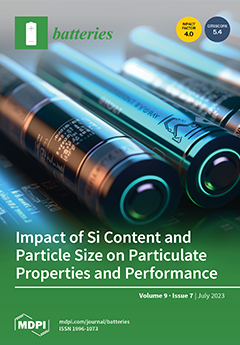A composite electrode of carbon nanotube CNT@Mn
3O
4 nanocable was successfully synthesized via direct electrophoretic deposition onto a copper foil, followed by calcination. By uniformly depositing Mn
3O
4 nanoparticles on CNTs, a nanocable structure of CNT@Mn
3O
4
[...] Read more.
A composite electrode of carbon nanotube CNT@Mn
3O
4 nanocable was successfully synthesized via direct electrophoretic deposition onto a copper foil, followed by calcination. By uniformly depositing Mn
3O
4 nanoparticles on CNTs, a nanocable structure of CNT@Mn
3O
4 can be formed, where the CNT acts as a “highway” for electrons and ions to facilitate fast transportation. Moreover, capacitive energy storage processes play a crucial role in lithium (Li) storage, especially during high scan rates. The significant contribution of capacitance is highly advantageous for the rapid transfer of Li
+ ions, which ultimately results in an improved reversible capacity and prolonged cycle stability of the battery. A high specific capacity of 1367 mAh g
−1 was maintained over 300 charge–discharge cycles at a current density of 1 A g
−1, indicating excellent capacity retention and an extended cycle life. Furthermore, the synthesis process was facile and cost-effective, obviating the need for complex procedures such as mixing and pasting. Additionally, no binder was required, thereby enhancing battery quality efficiency.
Full article





